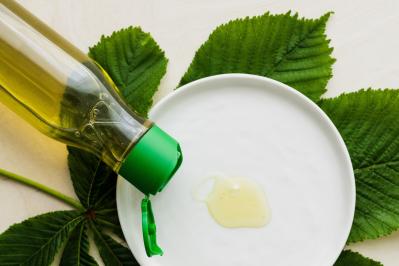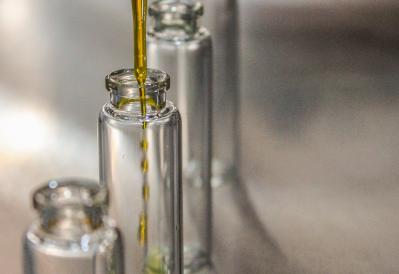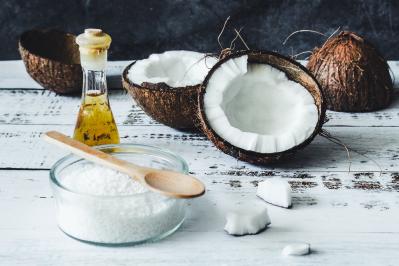
Analysis of oils & fats
Oils and fats are essential components of our diet and play a significant role in our health. They are important suppliers of energy, provide essential fatty acids and are necessary for the absorption of fat-soluble vitamins.
However, oils and fats have different origins and diversity, which affect their properties and uses. Therefore, it is important to have these products analyzed in the laboratory to verify their quality, composition and safety.
Origin and variety of oils & fats
The origin of oils and fats can be vegetable or animal. Vegetable edible oils are derived from seeds, nuts or fruits of plants, while animal edible fats are derived from animal tissues. There are a variety of vegetable and animal oils and fats that differ in their fatty acid compositions, flavors, smoke points, and uses. Examples of vegetable oils include olive oil, sunflower oil, canola oil, and coconut oil, while butterfat, lard, and tallow are examples of animal fats.
The diversity of edible oils and fats also extends to their processing and additives. There are refined and cold-pressed oils, which differ in their manufacturing process and quality. In addition, oils and fats may be treated with various additives such as antioxidants, preservatives, or flavorings to improve their shelf life or flavor characteristics.
Laboratory analysis of oils and fats is of great importance to ensure their quality and safety. Laboratory testing can be used to determine the composition of fatty acids in oils and fats to ensure that they conform to declared claims and meet nutritional requirements. Residues of pesticides, heavy metals or other contaminants can also be checked to ensure that products meet regulatory limits and are safe for consumption. In addition, analysis can help detect potential adulteration or counterfeiting of oils and fats that may pose a risk to consumer health.
It should be noted that laboratory analysis of oils is complex and requires specialized knowledge and equipment. Therefore, it is important to work with accredited laboratories to obtain accurate and reliable results. Tentamus Group's accredited laboratories routinely provide analysis of oils and fats and are happy to discuss your requirements with you.
Challenge for producers & distributors of oil
There are several challenges for producers and marketers of oils regarding the safety of their products. Some of the main issues are:
- Adulteration and counterfeiting: edible oils can be fraudulently adulterated or counterfeited by stretching or substituting them with inferior or cheaper ingredients. This can affect the quality and safety of the product.
- Impurities: Oils may contain impurities such as pesticides, heavy metals, mineral oils, microbial contaminants or other undesirable substances that may pose health risks to consumers. These contaminants can enter the edible oil during cultivation, processing, storage or transportation.
- Quality Consistency: Oils can vary in quality and characteristics depending on factors such as growing and harvesting methods, processing techniques, and storage conditions. It can be challenging to ensure consistent quality of oils. This is especially the case when they come from different sources or regions.
- Ingredient labeling: Proper declaration of ingredients in oils is critical to providing consumers with accurate information about the content and composition of products. However, it can be difficult to determine the exact composition of oils, especially when they contain complex mixtures of different ingredients.
- Formation of PAHs (polycyclic aromatic hydrocarbons): PAHs can be formed when oils are heated during the manufacturing process, especially during refining and processing of oils. Particular attention should be paid to benzo(a)pyrene. Some PAHs are considered potentially carcinogenic and may pose health risks to consumers. For this reason, many countries have limits for PAHs in food, including edible oils. These limits vary by country and may apply to specific PAH compounds or to the total amount of PAHs.
To address these challenges and ensure the safety of oils, it is important to implement strict quality controls throughout the supply chain from production to sale. This can include the implementation of Good Manufacturing Practices (GMP), food safety systems such as Hazard Analysis and Critical Control Points (HACCP), and laboratory testing to verify the quality, composition and safety of oils. Regular monitoring, testing and certification by independent third parties can help ensure the safety of oils and fats and increase consumer confidence in the products.
Specific challenges with olive oil
The safety of olive oil products can be affected by several challenges that olive oil producers and marketers face. Some of the main challenges are:
- Authenticity and quality: Olive oil is particularly vulnerable to food fraud, such as the admixture of low-quality oil or the use of inauthentic olive oil varieties.
- Contaminants: Olive oil can be contaminated by impurities such as heavy metals, pesticides, or residues of processing aids. These can enter the product during cultivation and harvesting as well as during processing and storage.
- Storage and Transportation: Proper storage and transportation of olive oil products is essential, as olive oil is susceptible to oxidation and loss of quality. Maintaining proper storage conditions such as light, temperature and humidity control can be critical to ensure the quality and safety of olive oil products.
- Regulatory Requirements: Compliance with national and international regulatory requirements can be a challenge for producers and marketers of olive oil products, as they are constantly changing and can vary. This includes, for example, labeling requirements, limits on impurities and residues, and olive oil quality standards.
- Consumer expectations: Increasing consumer expectations regarding authenticity, quality, sustainability, and transparency of olive oil products pose another challenge. Producers and distributors must meet these expectations and may need to provide additional certifications, labels, or information to gain and maintain consumer trust.

Necessary tests for the analysis of oils & fats
Residue Analysis
Oils and fats can have a variety of residues. Some of the most common are:
- Pesticides: oils and fats may contain residues of pesticides used during the cultivation of crops for oil or fat production. These may include insecticides (e.g., chlorpyrifos, diazinon, and malathion), herbicides (e.g., glyphosate, atrazine, and diquat), or fungicides (e.g., azoxystrobin, boscalid, and thiabendazole) used to protect crops from pests or diseases.
- Animal drug residues: In some cases, animal fats may also contain residues of veterinary drugs used to treat diseases in livestock. Examples of veterinary drug residues that may be found in edible oils and fats include antibiotics, antiparasitics, and hormones.
- Phospholipids: phospholipids in oils may indicate undesirable contamination with phospholipids, which can affect the quality and stability of the oil.
- Sterol analysis: this analysis determines the content and composition of sterols in an oil, which can be used as a marker for the authenticity and quality of oils (especially olive oil).
- Analysis of contaminants: This includes the determination of heavy metals, polycyclic aromatic hydrocarbons (PAHs) including benzo(a)pyrene, and petroleum components and other contaminants that may be present in oils and may indicate their safety and quality.
It is important to note that the amount and type of pesticides and residues in oils and fats depend on several factors, such as the type of oil or fat, the method of cultivation, pesticide application guidelines, and residue limits in different countries. Regulatory agencies monitor and set limits for pesticide residues in foods, including oils and fats, to ensure consumer safety.
Analysis of pesticides and residues in oils and fats is usually done using specialized analytical methods performed in laboratories. Here are some common methods used for the determination of pesticides and residues in oils and fats:
- Gas chromatography (GC)
- Liquid chromatography (LC)
- Mass spectrometry (MS)
- Enzyme-linked immunosorbent assays (ELISA)
The analysis of pesticides and residues in oils and fats requires special knowledge and experience to obtain accurate and reliable results. Tentamus Group's qualified laboratories or experts can perform residue analysis for your products and help you comply with the appropriate limits.
Chemical analyses
There are various chemical analyses that can be performed on oils to determine relevant fat parameters. These allow conclusions to be drawn about their quality, composition and safety. These include:
- Fatty acid spectrum: this analysis determines the content and composition of fatty acids in an oil. It can help determine which types of fatty acids are present in an oil, such as saturated fatty acids, monounsaturated fatty acids and polyunsaturated fatty acids. Fatty acid composition is an important factor in the quality of oils and can have an impact on the sensory properties, shelf life and health benefits of the oil.
- Peroxide value: The peroxide value is a measure of the level of peroxidic compounds in an oil and may indicate oxidative degradation and rancidity. A high peroxide value may indicate an undesirable oxidative change in the oil, while a low peroxide value indicates good quality and stability of the oil.
- Anisidine value: The anisidine value is a measure of the content of aldehydes and ketones in an oil, which may indicate oxidative degradation. A high anisidine value may indicate undesirable aging and decomposition of the oil.
- Acid number: The acid number is a measure of the free fatty acid content in an oil. A high acid number may indicate increased acid formation or poor quality of the oil.
- Saponification number: The saponification number is a measure of the amount of free fatty acids and glycerides in a fat or oil and is often used to characterize fats and oils.
With the help of our qualified laboratories and experts in the Tentamus Group, you can obtain reliable information about the fat indices of your products.
Analysis of Origin
The origin of an oil can be determined by various analytical methods and indicators. In the laboratories of the Tentamus Group we can perform the following methods for you:
- Chemical fingerprints using NMR: The chemical composition of oils can vary from region to region, depending on factors such as soil characteristics, climate, cultivation practices and other environmental factors. By determining chemical components or specific compounds in an oil, such as fatty acids, sterols, phenols, or carotenoids, characteristic fingerprints can be established that may indicate the origin of the oil. These fingerprints can be compared to reference samples from known origins to determine the origin of an unknown oil.
- Isotopic analysis: Analysis of the isotopic ratios of elements in oils can provide information about geographic origin. Isotopes are variants of an element with different numbers of neutrons in the nucleus. By determining isotope ratios of elements such as carbon, hydrogen, oxygen, or nitrogen in an oil, characteristic patterns can be identified that may indicate the origin of the oil. These patterns can be compared to isotope ratios of reference samples from different geographic regions to determine the origin of the unknown oil.
- DNA analysis: determination of DNA in oils can be used to identify plant or animal species present in an oil. By comparing DNA sequences to reference databases of different species or varieties of plants or animals, conclusions can be made about the origin of the oil. This method is commonly used with vegetable oils to verify the authenticity and genuineness of oils and to identify undesirable impurities or admixtures.
- Organoleptic analysis: this is a sensory evaluation method in which trained tasters evaluate olive oil based on sensory characteristics such as taste, smell and appearance. Specific criteria are used to assess the varietal purity of the olive oil and determine if it meets the organoleptic characteristics of a particular olive variety. This method is often used in conjunction with other analytical methods to confirm varietal purity.
The origin of an oil is usually not determined by a single analytical method alone, but often by combining several approaches and comparing them with reference samples or databases.
Sensory analysis
Sensory analysis of oil refers to the evaluation of sensory characteristics such as taste, odor, and appearance to assess the quality, purity, or authenticity of the oil. There are several approaches to sensory analysis of oil. Among others, panel tests, tastings or organoleptic testing can be performed.
Our trained technical staff will be happy to advise you on the most suitable method for your products.
Labeling
Label testing of oils and fats is an important step in ensuring that the information provided on products is accurate and complies with applicable regulations and standards.
Labeling verification involves checking all information on the label or packaging of the oil or fat. This includes, for example:
- the name
- the origin
- the ingredients
- the expiration date
- the nutritional information
- allergen labeling
- GMO labeling
Labeling verification is important to protect consumers from deception and misleading, to ensure the quality and authenticity of oils and fats, and to ensure that products comply with applicable regulations and standards.
Tentamus Group's international labeling team can perform appropriate labeling tests for you and, if necessary, provide additional verification of the claims by means of laboratory analysis. We look forward to advising you!

Sample shipment
for the analysis of oils & fats
Oil and grease samples should be carefully packaged for shipment to laboratories to ensure safe and reliable analysis. Here are some important steps and tips for shipping oil and grease samples to laboratories:
- Sample containers: use clean and appropriate sample containers for the type of sample and analysis planned. Ensure that containers are well sealed and leak proof to prevent contamination or adulteration of the sample.
- Transport: Select the appropriate transport route and transport service provider to ensure that the samples arrive at the laboratory within the required time and under suitable conditions. In doing so, also observe applicable regulations for the transport of samples, especially with regard to special requirements for certain types of samples or analyses.
- Sampling: sampling can be done either independently or directly by our samplers.
Our logistics and sampling team can provide further advice on this.

Relevant legal bases & directives
Get in touch with our team:
food@tentamus.com
+49 30 206 038 230
Overview of
laboratories offering analysis of oils & fats
The following laboratories from the Tentamus Group offer analysis of oils & fats
This could also be of interest to you:
Analyses
Residue analysis
Chemical analyses
Analysis of origin
Sensory testingProduct Categories
Nuts
Dried fruit
Baked goods
Dietary supplements
Potato Chips and Snacks
Baby food
Hemp productsOther Services
Labeling
Hygiene training
Sample logistics
Detection of food fraud